City of London Pubs (1973): Forty Years On – Part 3
June 18, 2014
This is the third part of my walk following the route of City of London Pubs: A Practical and Historical Guide by Timothy M. Richards and James Stevens Curl.
AREA 3: SMITHFIELD AND ST BARTHOLEMEW’S

The majority of the pubs in the area first appeared when the modern Smithfield meat market opened in 1868. With the coming of the railways came the men to work in the market; and with the men came the pubs.
No.32 – THE VICTORIA HOTEL, 25 Charterhouse Street, EC1
In 1973, this pub was one of many in the area which displayed a sign displaying “the vital information that anyone lawfully engaged on business in the market may drink here from the hours of 5 to 8 o’clock in the morning. It is the first of several such signs in the vicinity”, which applied only to the local Smithfield meat-market workers.
While Richards and Curl felt the “main recommendation for visiting the pub itself…is the good-humoured people by whom it is used”, those people are long gone. When I visited, the block where the pub formerly sat had been demolished, part of the Crossrail development dominating the area around Farringdon Tube.
No.33 – THE HOPE, 94 Cowcross Street, EC1
The pub was built in 1790 and much of the character of its Victorian heyday remains intact. It is still recognisable from the description back in 1973 – “an unusual front, with bow window and large fanlight over a granite plinth” – and Richards and Curl celebrated the “encaustic tiles in the corridor and entrance, and fine etched glass panels in the screen separating the bar from the corridor.”
Sadly, when I visited, one of the glass panels in an exterior door had suffered a vast crack from top to bottom. It looks like the sort of damage that’s hard to put right.
No. 34 – THE SMITHFIELD TAVERN, 105 Charterhouse Street, EC1
In 1973, the narrow pub possessed a bar-billiards table, a strange hybrid of pool and skittles – Richards and Curl mention the table was one of the very few to be found in the City, “partly because so few pubs have a space” for it. The bar-billiards table is no longer there, replaced with ordinary tables for diners.
The Smithfield Tavern spent the period from 2006 to 2009 under the name ‘The Wicked Wolf’, and while its original name has been brought back, it still looks as if its attempting to draw in a younger crowd. Most of the original interior has been removed, and when I passed, it had been replaced with record decks, low leather pouffes, and the lowest level lighting I’ve ever seen inside a working building.
Richards and Curl also remarked on the Tavern’s unusual pub sign, which showed “two male figures talking to one another, and from their dress they appear to be Jewish rabbis.” This has since been replaced with a more generic landscape.
No.35 – THE FOX AND ANCHOR, 115 Charterhouse Street, EC1
“In shape, this is the Smithfield’s twin”, but in 2014, the Fox and Anchor (most likely named, according to Richards and Curl “after nearby Fox and Knock Street” – streets which don’t seem to exist, but which I’ve not been able to find any more information about) retains more traditional pub fittings.
Most notable is the “splendid exterior [of 1898]…a complete Art Nouveau facade of moulded cast stone, with coloured decorations very reminiscent of the work of Neatby at Harrod’s meat hall.”
The pub was restored to its original Victorian splendour in 1986, and is today a fine example of that definitive style of pub architecture.
No. 36 – THE SUTTON ARMS, 6 Carthusian Street, EC1
On a road named after the former Carthusian monastery, founded by Sir Walter Manny in 1371 and today known as The Charterhouse, The Sutton Arms is another fine, solid Victorian pub.
The interior had been modernised when Richards and Curl visited in 1973, but the “fine exterior” and “good glazed tiles at the entrance” are still there today. Popular legend has it that the pub is haunted by a red-headed elderly man, nicknamed Charlie, who appears fleetingly before disappearing.
No. 37 – THE OLD RED COW, 71-72 Long Lane, EC1
“The origin of this name is simplicity itself,” wrote Richards and Curl in 1973. “As old red cows are a rare sight in this country, it follows that their milk (beer) is of great value.” Once very popular with market porters, this small pub (the upstairs room is a restaurant, so the pub is just the single downstairs room) is well preserved.
With entrances from two sides, it also has a board explaining its history on the outside wall, making it one of the few pubs to boast about a historical connection with the relatively modern coupling of Bernard Miles and Peter Ustinov.
No 38 – THE HAND & SHEARS, 1 Middle Street, EC1
The Hand & Shears – or “The Fist and Clippers, as it is affectionately dubbed by locals” – is earlier than many of the pubs surrounding it, dating from the early 1800s. In 1973, Richards and Curl called it “relatively unspoilt…an excellent example of a traditional nineteenth-century pub.”
There has, however, been an inn on the site since the Middle Ages – the date above the pub’s entrance proclaims it was established in 1532. A popular inn used by cloth merchants (which gave the pub its name), it was used as the venue to settle disputes and grievances of people who visited the annual St Bartholomew’s Fair – licences were granted, weights and measures were tested, and fines imposed on fraudulent traders. For many years, the Fair was officially opened from the inn’s doorway by the Lord Mayor – but impatient clothiers would later wait at the pub the night before and declare it open on the stroke of midnight, signalling to gathering crowds that the Fair was officially open by waving a pair of shears in their hands.
It was the busiest of the pubs I passed on this leg of the trip, and the people inside looked so jovial. It’s the only one I didn’t have a drink in that I wish I had.
No.38b – THE RISING SUN, Rising Sun Court, EC1
Richards and Curl mention The Rising Sun in passing – “although the old pub of that name is still visible, it no longer rings to the sound of voices.” Today, in a surprising turn of events, the pub that had been closed in 1973 has come back to life.
Hidden away in a quiet street, it’s a welcoming little pub with a vast stretch of frosted windows making up two entire sides of the inn.
It is the only pub featured in City of London Pubs to have come back from the dead.
No. 39 – THE BARLEY MOW, 50 Long Lane, EC1
A Victorian pub, by 1973 it had become “a ‘modern-traditional’ pub,” wrote Richard and Curl, “camped up with panelled walls, wooden bar, restrained colour scheme, and good cast-iron tables.”
Today, the Barley Mow is an Italian restaurant, Apulia. At the top of the building’s facade, the old pub’s name can still be seen.
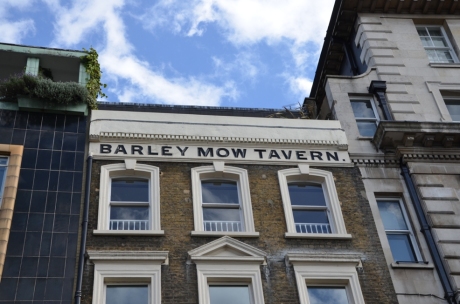
No. 40 – THE RUTLAND, 9-10 West Smithfield, EC1
“Every so often one stumbles across a particular brewery’s only house in the City, and The Rutland is Shepherd Neame’s sole representative”, wrote Richards and Curl in 1973. The pub is still here, but has been renamed The Bishop’s Finger, after one of the Shepherd Neame brewery’s most popular beers.
Apart from the name change, the pub is much the same as it was in 1973, when Richards and Curl admired the exterior and “three cast-iron columns with fine capitals”, but noted “nothing else remains of the original decor.”
No. 41 – THE COCK TAVERN, Central Markets, Smithfield, EC1
In 1973, the Cock Tavern sat in two subterranean rooms beneath the Central Market , “utilitarian to the extreme.”
It catered primarily for the porters, with opening hours from 5.30pm to 3pm, and its alcohol licence coming and going through the day – it opened at 5.30am to sell only food, was able to sell alcohol from 6.30am, but then from 9.30am to 11.30am could only sell food, and was once again able to sell alcohol from 11.30am until closing time at 3pm.
Even though it had become very popular due to its inclusion in lots of articles about ‘Secret London’, the Cock’s purpose was lost when the Market closed and it shut its doors for the final time in 2013.
No. 42 – THE NEWMARKET, 26 Smithfield Street, EC1
Now an upmarket gold-and-black bar called Bird of Smithfield and offering ‘libations’ instead of pints, in 1973 The Newmarket was a saloon bar boasting a “glass mirror along one wall…engraved with a horse-racing scene.” It seems likely this was an error by a later owner, who didn’t realise the pub had been named after the new meat market outside, rather than the horse racing course.
Upstairs in 1973 was “a large mural of the old open-air market”, but I was unable to see if this remains.
No. 43 – THE WHITE HART, 7 Giltspur Street, EC1
“Here is the most lavish pub encountered for some time,” wrote Richards and Curl, “with heavily upholstered seats and settees, low coffee-type tables, a Black Watch tartan carpet, soft music, and subdued lighting.”
This lavish 1907 pub is now gone and has been turned into offices – the only reminder of its former use is the antlered stag head above the doorway.
No. 44 – THE VIADUCT TAVERN, 126 Newgate Street, EC1
Richards and Curl were delighted by this pub in 1973: “Named, of course, after Holborn Viaduct…the pub is a splendid example of Victorian design. This is a full-blown corner pub, built on a curve, with glazed ground floor. Inside are wooden screens, finely carved, with exquisite engraved glass panels of folitate design. There is wonderful ornate gilded and silvered glass by the staircase, and a manager’s stall, with an ornate pulpit-like exterior, cornice and clock, and engraved glass, some curved.”
Today, the Tavern is much the same, but the road outside is so busy with traffic thundering past that the smokers might as well have been standing on the hard shoulder of the M1.

No. 45 – THE MAGPIE AND STUMP, 18 Old Bailey, EC4
Standing in an alleyway opposite the Old Bailey, during the eighteenth century, the pub hired out the upper rooms to people wanting an unobstructed view of the executions in Newgate prison, which stood opposite.
The practice continued under 1868, but a reminder can be seen on the board outside – promoting “Last Pint Friday”, it’s a half-price offer ‘commemorating’ the pub’s tradition of sending a final pint to condemned men.
In 1973, Richards and Curl admired the “dark panelling, leaded windows, carpeted floor and winged bench seats” of the pub, which had been rebuilt in 1931. None of these remain today, and the pub has the rather cold look of a wine bar – black furniture, checkerboard patterns on the floor, and grey feature walls.
No. 46 – THE GEORGE, 25 Old Bailey, EC4
No.46 – THE RUMBOE, 27 Old Bailey, EC4
The George was a nineteenth-century pub, the Rumboe amid-twentieth century one (its unusual name came from a ‘posh’ name for Newgate Prison used by thieves) but both have been entirely swept away by a large new office development, New Ludgate.
The developers call it “a striking contemporary addition to one of London’s most historic locations.”
THE TALLY SO FAR:
Pubs covered in 1973′s City of London Pubs still open: 27 (3 renamed)
Pubs covered in 1973′s City of London Pubs now closed: 19
Pubs covered in 1973′s City of London Pubs which had closed and are now open: 1
Note: surprisingly, there are two pubs which have opened up in Smithfield since City of London pubs was written – and I say ‘surprisingly’ because I thought they’d been there for years.
The Fuller’s Ale and Pie House and the Butcher’s Hook and Cleaver on West Smithfield have the look of long-established Victorian pubs, but they were opened in November 1999 (Fuller’s own both, so while they look distinct, perhaps they should count as a single pub divided into two.) They replaced the two properties there previously, a meat wholesalers and a branch of the Midland Bank.
NEXT UP: AREA 1!
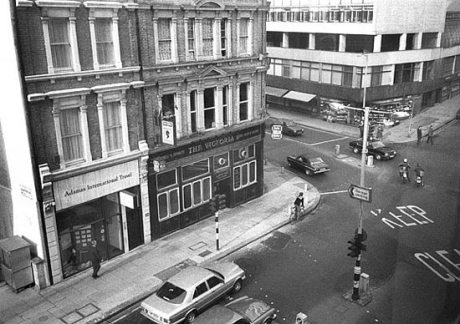




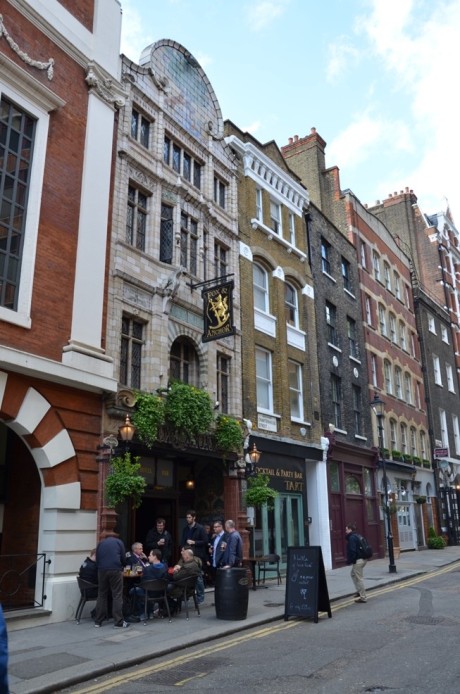
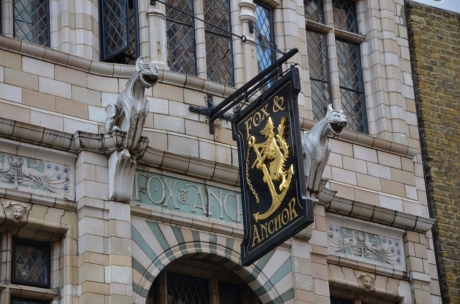

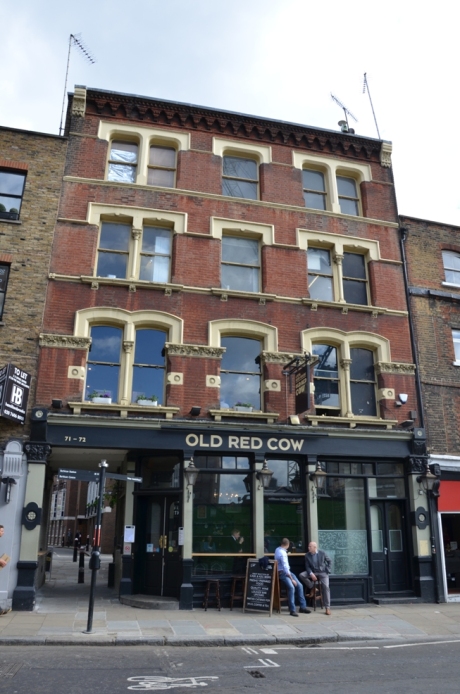
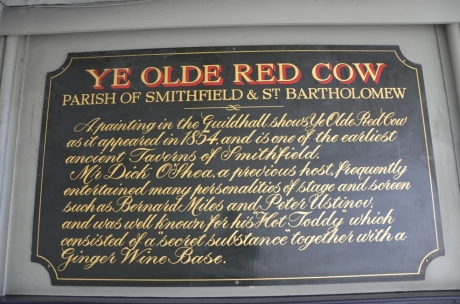
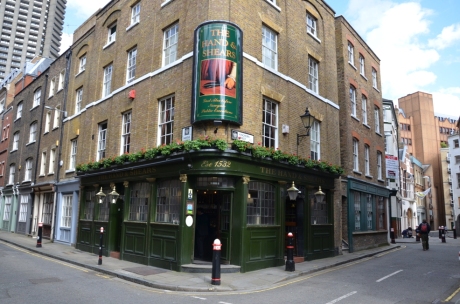
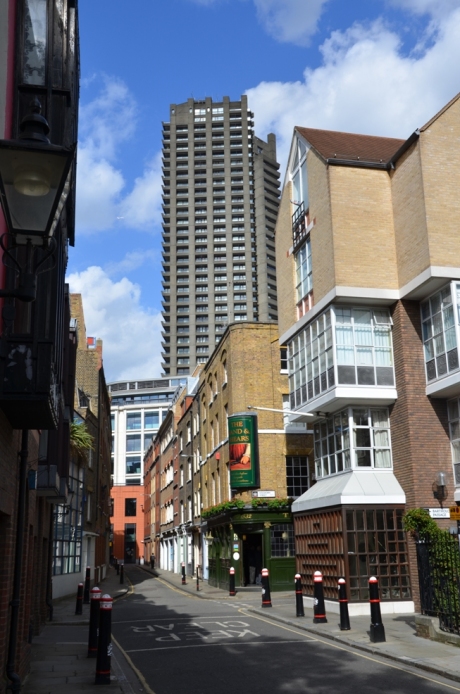
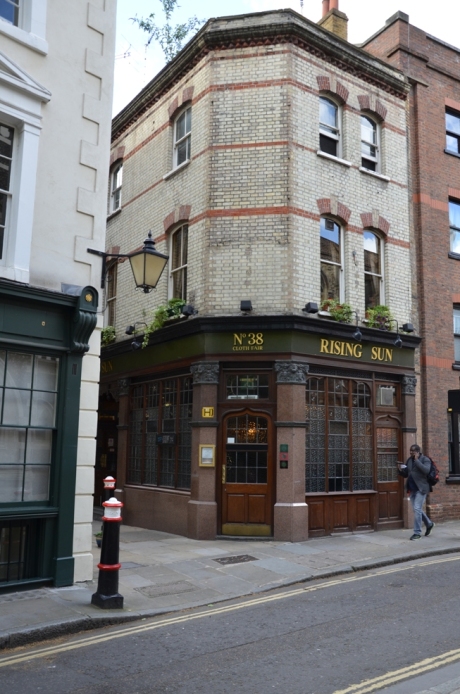
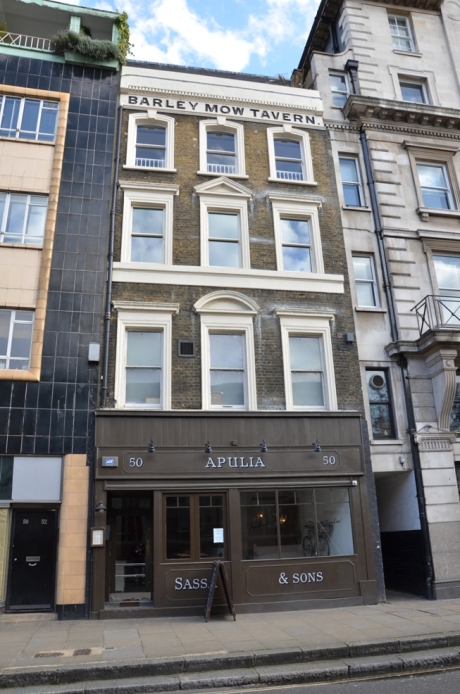


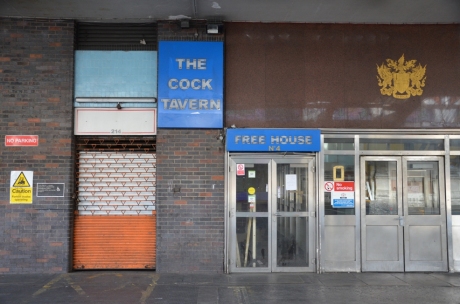


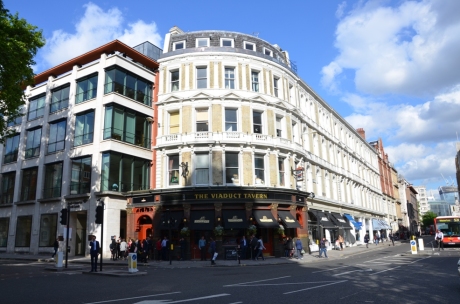

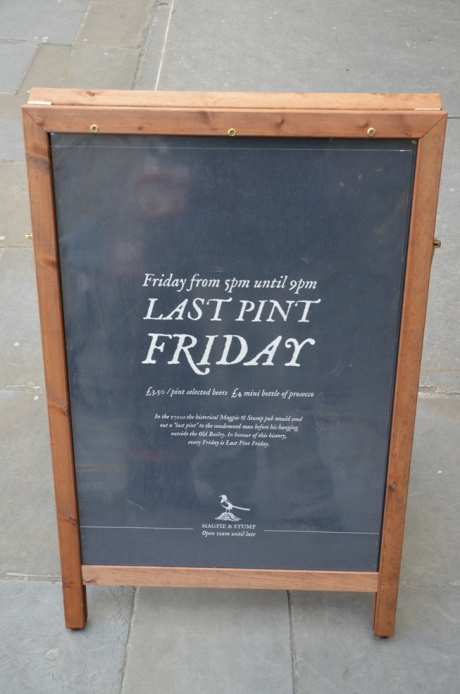
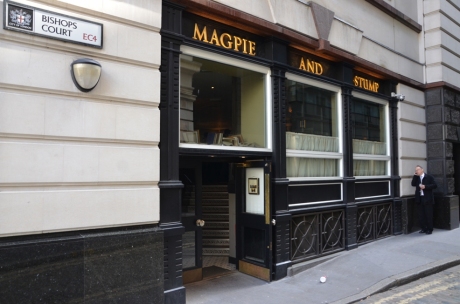
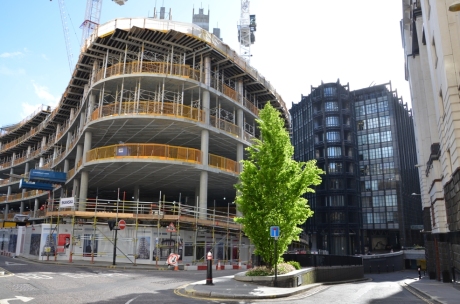


Smashing addition to the series. The Hand and Shears is wonderful, mostly thanks to the Landlord who is the embodiment of cheerfulness and courtesy, even when things get busy. I think the Magpie and Stump was closed for many years until recently reopening under its old name.
[…] pub crawl around Smithfield, 1970s […]
[…] pub crawl around Smithfield, 1970s […]
[…] pub crawl around Smithfield, 1970s […]
A very enjoyable post – thanks! I love some of the pubs in this area, particularly the Hand & Shears and Rising Sun, which are like sanctuaries from the gastro-scotch-egg re-inventions in the surrounding area. I am not sure your picture of #43 The White Hart is right, though. The White Hart was next door (to the right) of this building (see http://pubshistory.com/LondonPubs/StSepulchre/WhiteHart.shtml) at No.7 – this building is No.8-9 Giltspur St. I have often wondered about the magnificent stag’s head above the door, but I can find very little information about the building’s original use. I know it was once used by Silkin & Silkin solicitors, and was more recently flats, but I’d love to know about its beginnings…
http://www.closedpubs.co.uk/london/ec1_clerkenwell_whitehart.html
The entry re the White Hart in Gilspur St is incorrect. The White Hart was the building to the right (when facing) of the building shown. See photo on http://www.closedpubs.co.uk/london/ec1_clerkenwell_whitehart.html
I visited the building today. It is still there but covered with scafffolding so I couldn’t see if the stag’s head was still there.
The photograph of the current site of Pub 32, the Victoria Hotel, is incorrect. The Victoria was on the north-west corner of Charterhouse Street and Farringdon Road to the left of the site photographed (Charterhouse Street is on both sides of Farringdon Road). The number on Richards and Curl’s map appears to be slightly out of position. I did drink in the Victoria once in December 1989 at 5:30 am after working a night shift at Mount Pleasant. Some of my drinking companions were carrying on from their office Christmas party from the night before. Shortly after that it was demolished and an office block built on the site. The Victoria was not actually in the City of London but just over the border in Westminster.
Correction. The Victoria, 25 Charterhouse Street was in the London Borough of Camden not Westminster
The four pubs to the north of Smithfield Market, the Hope, the Smithfield Tavern, the Fox & Anchor and the Sutton Arms in Carthusian Street are not in the City of London but are in Islington. The border between the City and Islington runs just north of Smithfield Market along the middle of Charterhouse Street, Charterhouse Square and Carthusian Street.
Here is a link to what was the actual site of the Victoria
on the opposite side of Farringdon road to the photo shown above.
http://www.closedpubs.co.uk/london/ec1_clerkenwell_victoria.html
Further to my previous comment of July 10 2014 the scaffolding has been removed from 8/9 Gilspur Street and the stag’s head is visible again. However that building was not the White Hart. The White Hart was next door at 7 Glispur Street.
[…] Timothy M. Darkest London. (2014). Web. 11 Feb 2016 < https://darkestlondon.com/2014/06/18/city-of-london-pubs-1973-forty-years-on-part-3/ […]
“No. 45 – THE MAGPIE AND STUMP, 18 Old Bailey, EC4
In 1973, Richards and Curl admired the “dark panelling, leaded windows, carpeted floor and winged bench seats” of the pub, which had been rebuilt in 1931. None of these remain today, and the pub has the rather cold look of a wine bar – black furniture, checkerboard patterns on the floor, and grey feature walls.”
The reason why none of these features remain is because that building was demolished in the late 1980s, and the present public house is within the modern re-development.
The current iteration of the Magpie and Stump (the main building itself is being renovated and re-clad) is as an ‘Old Bailey’ theme bar.
The Cock Tavern is now Oriole, a cocktail bar with live jazz.
The Hope closed in June 2016 but reopened in December after a refurbishment. It now no longer uses the early morning licence and opens at 11am,
The Barts song every Barge medical student knows has a refrain,
“From the Whit Hart to the Magpie down Smithfield as I stagger by, for the last pint of the evening at the old Hand & Shears.”
The White Hart had gone by the time I was a student, and the Magpie and Stump was closed for a time in the 1980s I think. Most stuxents frequented either of the two Sutton arms- known by us as the front or back Sutton.
Until 1952, the Smithfield Tavern traded under its original name of the Red Cow which must have proved mighty confusing with the Old Red Cow over in Long Lane. It closed in 2015 and is boarded up, future unknown.
The Fox & Anchor may be named after an adjacent street, but it’s Fox and Knot Street not Fox and Knock Street, which still exists.
See: https://www.google.co.uk/maps/@51.5203691,-0.1005137,3a,37.5y,74.14h,112.34t/data=!3m6!1e1!3m4!1sq-Qj6M_NHRrmh5GNGihlhw!2e0!7i13312!8i6656
Until last year, the Sutton Arms displayed a hanging sign with the date 1611, later removed along with the Charrington’s bar back by Fuller’s. The current Charterhouse incarnation was established by Thomas Sutton in 1611.
The Newmarket (originally New Market Hotel) was Victorian, destroyed during World War II and rebuilt in 1964 – the Bird of Smithfield website states it’s a five-storey Georgian townhouse, which is tosh.
The Rising Sun stopped operating as a pub during World War II and did not operate as a pub until the mid 1980s when it was reopened by Sam Smith’s
The Hope now opens at 7am on Monday to Friday.
The Smithfield Tavern has been closed since 2015 but building work is going on and I understand that it we reopen as some sort of licensed premises.
The Smithfield Tavern reopened as a Simmons bar in 2018. The Hope now opens at 9am.
Excellent article. I absolutely appreciate this site.
Keep writing!